Matt Rees's Blog - Posts Tagged "fourth"
Nasty nargila and biblical heat on video
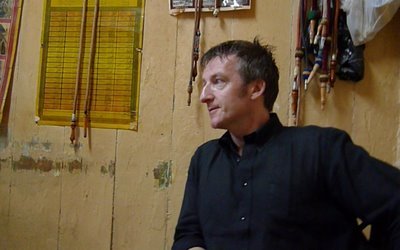
My favorite little coffee shop in Jerusalem’s Old City is just inside the Muslim Quarter, behind the Church of the Holy Sepulcher where Jesus is believed to have been crucified, buried and resurrected.
Once you’ve sucked on the tobacco in this café, even hanging on a cross with nails through your hands and feet would be a relief. It's like smoking a three-foot-long unfiltered Gauloise.
But I keep going back. I like the location -- down the steep narrow alley outside the café, a short walk takes you to the Cotton Souk and straight onto the Temple Mount by the side of the Dome of the Rock. I like the environment, too. The men (only men) puffing on their nargilas are friendly and talkative. The volume on the radio is unpredictable. The electricity keeps cutting out. The plaster’s peeling from the walls, and the toilet is a stomach-churning masterpiece by a coprophiliac Jackson Pollock. Yes, it’s a great spot.
This week I stopped in to shoot a video for my next novel, THE FOURTH ASSASSIN, which will be out in February. The book’s set in Brooklyn. My Palestinian detective Omar Yussef travels there to visit his son, only to find a dead body in his son’s apartment. The action of the book takes place mostly in Bay Ridge, which is becoming “Little Palestine” due to an influx of Palestinian immigrants. There are also chapters around the U.N. in Manhattan and in Coney Island.
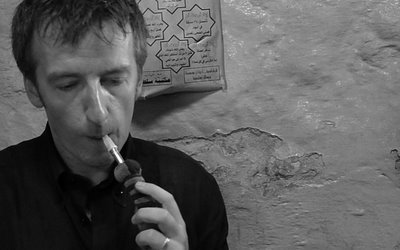
My videographer David Blumenfeld and I decided to shoot the atmospheric background shots in Brooklyn. My pieces to camera: in the café.
As David set up the lights and the two cameras, I negotiated with the fellow who serves the coffee to make the place a little quieter for our recording. I asked if he’d mind turning off the radio (“It doesn’t really work anyhow,” I told him, as the radio cut out once again. “But when it does, people like it,” he said.) and the noisy fan (“What fan?” he said, wiping his sweaty moustache. “Oh, that thing.”)
I hoped the nargila would throw off some atmospheric smoke, as it usually does, giving our shot a noirish quality. The particular brand of tobacco bubbling through the water pipe that day was the nastiest I’ve ever encountered. And no smoke. Just an invisible poison that left me hacking through my script and reaching for my glass of coffee.
(Incidentally, in the Jerusalem accent a “nargila” is an “’argila,” because they often drop the opening syllable of a world. Thus, the only place in the Arab world where they can’t pronounce “al-Quds,” the word for Jerusalem in Arabic, is Jerusalem. They call it “al-‘uds” here.)
After a couple of hours of sucking on the nasty pipe and clearing my throat with thick, cardamom-flavored coffee, I’d done the script in English, French, Italian, and German. I was too jittery to sit there any longer. David and I hauled our equipment to the beautiful Austrian Hospice, a hotel and coffee shop on the Via Dolorosa.
On the roof of the Austrian Hospice, David filmed me reading the opening chapter of THE FOURTH ASSASSIN. It was the height of the afternoon sunshine and I was unwisely wearing a black shirt (trying to look noirish again). David pulled out a big reflector disc to direct light to the unlit side of my face. It blinded me. “Isn’t that how King David defeated the Philistines?” I said.
When in Jerusalem, you know, stick to the Bible.
We’ll be editing the video for THE FOURTH ASSASSIN this month and posting it to Youtube. Meanwhile, you can see the videos for my first three books on my website.
UK cover for THE FOURTH ASSASSIN
It's always a thrill for me to receive the covers of my forthcoming novels from my UK publisher Atlantic Books. They have a series feel in that there's a continuity to the design. Each one seems to get better. Here's the cover of THE FOURTH ASSASSIN, which will be published next February. I received it from my delightful editor in London Sarah Norman just this week.
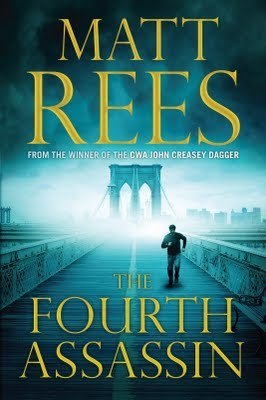
In THE FOURTH ASSASSIN, Omar Yussef leaves his regular haunts in the West Bank and Gaza Strip. He travels to New York for a UN conference, he's eager to visit his youngest son, Ala, who lives in Bay Ridge, a Brooklyn neighborhood with a large Palestinian community. He arrives at Ala's apartment to find the door ajar and a headless body in one of the beds. He's initially terrified that the dead man is his son, but soon Ala arrives and identifies the body as that of one of his roommates. He's convinced that his other roommate is the killer. But when the cops show up, Ala refuses to give an alibi and is arrested. Desperate to prove his son's innocence, Omar Yussef investigates. The murderer has left clues that refer to the Assassins, a medieval Shiite sect. When they were teenagers, Ala and his roommates had a club by that name. What's the connection? As Omar Yussef delves deeper, he uncovers a deadly international conspiracy.
On the subject of covers: My first Palestinian crime novel is just out in Indonesia (the second in the series A GRAVE IN GAZA was published there earlier this year). My wonderful editor at Dioma in Malang, Herman Kosasih, sent me copies of THE COLLABORATOR OF BETHLEHEM with, frankly, one of my favorite covers produced anywhere in the world for any of my books.
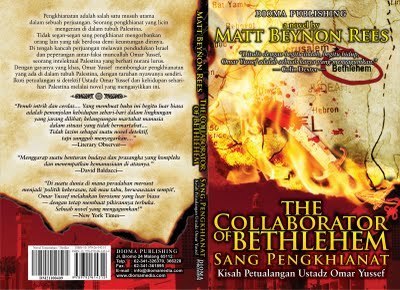

In THE FOURTH ASSASSIN, Omar Yussef leaves his regular haunts in the West Bank and Gaza Strip. He travels to New York for a UN conference, he's eager to visit his youngest son, Ala, who lives in Bay Ridge, a Brooklyn neighborhood with a large Palestinian community. He arrives at Ala's apartment to find the door ajar and a headless body in one of the beds. He's initially terrified that the dead man is his son, but soon Ala arrives and identifies the body as that of one of his roommates. He's convinced that his other roommate is the killer. But when the cops show up, Ala refuses to give an alibi and is arrested. Desperate to prove his son's innocence, Omar Yussef investigates. The murderer has left clues that refer to the Assassins, a medieval Shiite sect. When they were teenagers, Ala and his roommates had a club by that name. What's the connection? As Omar Yussef delves deeper, he uncovers a deadly international conspiracy.
On the subject of covers: My first Palestinian crime novel is just out in Indonesia (the second in the series A GRAVE IN GAZA was published there earlier this year). My wonderful editor at Dioma in Malang, Herman Kosasih, sent me copies of THE COLLABORATOR OF BETHLEHEM with, frankly, one of my favorite covers produced anywhere in the world for any of my books.

Published on August 14, 2009 04:52
•
Tags:
assassin, bethlehem, britain, collaborator, crime, fiction, fourth, indonesia, matt, nablus, omar, palestine, palestinians, publishing, rees, samaritans, yussef
Video: Reading from THE FOURTH ASSASSIN
The next in my series of Palestinian crime novels THE FOURTH ASSASSIN will be out early next year. Meanwhile I've made a couple of videos to introduce the book. In this one, I went up onto the roof of the Austrian Hospice in Jerusalem's Old City to read from Chapter One of the next book.
My latest culture clash
Here's my latest post on the International Crime Authors Reality Check blog:
The Austrian Hospice of the Holy Family is a beautiful sandstone building on the corner where the Via Dolorosa turns briefly onto the main alley of the Muslim Quarter’s souq. Buzz at the main gate, climb up two flights of enclosed steps, and you’re in a palm-shaded garden fronting a broad, four-story façade. Nearly 150 years old, it was built for Catholic pilgrims and for much of the second half of the last century was an insanitary hospital. Now returned to its original Austrian owners, it’s a hotel for church groups visiting the historic sites of Jerusalem.
From its roof, there’s a panoramic view of the Old City. It’s for this that I labored up the front steps with my friend, videographer David Blumenfeld, and his numerous camera bags, lights and reflector shields, last month. We’d already filmed a promo video for my next novel THE FOURTH ASSASSIN in my favorite seedy Old City café, where I shone with sweat, swallowed cardamom-flavored coffee and sucked on a foul nargila, until I looked sufficiently like an inveterate marijuana-user coming down. Now it was time for a second video.
I approached the front desk of the Hospice in the large marble entrance hall. A blonde man in his twenties greeted me: “Grüss Gott.” I’m a lover of things Austrian, so I had a good feeling already.
“Grüss Gott. We’re making a short video for my website. Can we film on the roof?”
“It’s not allowed, unless you have permission.” Not unfriendly. Just stating the rules.
But I’ve lived in the Middle East long enough to know that there ARE no rules. “Don’t worry. It’s really nothing. It’s just for my website. To tell people about my book.”
“What is the book?”
The truth: It’s about a Palestinian teacher who goes to visit his son in New York and discovers a headless body in his son’s bed. No, I’d better not tell him that. It doesn’t sound like something he’d want a pilgrim hostel associated with. How about this? “It’s about Palestinians and how they live their lives.”
A bit more of this and the Austrian was thinking hard. “Ok, but just for ten minutes.”
“Of course, thank you. That’s very kind of you. Ten minutes, of course.” In the Middle East, one of the things that really gets me down is that putting one over on someone else isn’t seen as a bad thing to do. If you can get away with it, then good for you. Naturally when I get the opportunity to do this, I have a feeling of payback for all the times I’ve been deliberately misled by the locals. With that warm sensation, I ascended in the Hospice’s rickety elevator.
Up on the roof, the afternoon sunshine was too bright to film. It was so harsh I’d have been squinting into the camera like Clint Eastwood. So David and I descended to the Hospice’s garden café. For a mere 100 shekels ($30) we had a slice each of strudel (an uncommon dish in Jerusalem, where even Israelis who arrived as immigrants from Austria tend to eat Middle Eastern style), some soda and coffee.
Suitably refreshed we returned to the roof and soldiered on, despite the insanely bright sunshine.
Despite the occasional loud Israeli on a cellphone and the Korean tourists who stopped taking photos of the Dome of the Rock so they could photograph me, I managed to read most of the first chapter of THE FOURTH ASSASSIN without a pause.
Then, just before I’d finished, from the corner of my eye I spy the blonde fellow from reception striding toward me.
“Sir, you have to stop now. This has been more than 10 minutes,” he said.
“We’ve only been working a few minutes. We were down in the café most of the time. We had strudel.”
He twisted his face as though his finger had just gone through the toilet paper. “And I should believe you?”
“Yes, why would I lie? Go and ask the people in the coffee shop.”
I feel for this Austrian. After all, Israelis and Palestinians are able to lie with absolutely no compunction. It’s one of the first things you learn when you live here a while. I could see that this poor fellow had been at the front desk of the Hospice for a sufficient time to train him to recognize a lie, but not long enough to give him the graceful Arab ability to maneuver around someone else’s untruths without humiliating them. This fellow had only two options: let me get away with it, or kick me out.
“So five more minutes and then you’re out,” he said.
Here’s where my own cultural training came in. The over-emotional Welshman in me wanted to say: Listen, butty, I paid 100 shekels for some stiff strudel in your café, so you can bloody well calm down. In any case what do you think I’m filming up here? It’s just my face, some domed buildings in the background, and a lot of sunshine. What’re you protecting? It’s not a military installation. I’m buggered if I’m going to be hurried by you.
But I also know that the Middle Eastern way is to move from bald-faced lieing to apparent humility and submission, smug in the knowledge that you’ve got what you want. So I let him think he was having his way.
Twenty minutes later, when David and I passed the reception desk on our way out, I stopped to wave my thanks to the Austrian. Never leave anyone with a nasty taste in their mouth. Arabs taught me that. The kisses on the cheeks they bestow after a dispute really do defuse all the tension.
He ignored me. A Palestinian would never have done that.
Here’s the video David and I made.
The Austrian Hospice of the Holy Family is a beautiful sandstone building on the corner where the Via Dolorosa turns briefly onto the main alley of the Muslim Quarter’s souq. Buzz at the main gate, climb up two flights of enclosed steps, and you’re in a palm-shaded garden fronting a broad, four-story façade. Nearly 150 years old, it was built for Catholic pilgrims and for much of the second half of the last century was an insanitary hospital. Now returned to its original Austrian owners, it’s a hotel for church groups visiting the historic sites of Jerusalem.
From its roof, there’s a panoramic view of the Old City. It’s for this that I labored up the front steps with my friend, videographer David Blumenfeld, and his numerous camera bags, lights and reflector shields, last month. We’d already filmed a promo video for my next novel THE FOURTH ASSASSIN in my favorite seedy Old City café, where I shone with sweat, swallowed cardamom-flavored coffee and sucked on a foul nargila, until I looked sufficiently like an inveterate marijuana-user coming down. Now it was time for a second video.
I approached the front desk of the Hospice in the large marble entrance hall. A blonde man in his twenties greeted me: “Grüss Gott.” I’m a lover of things Austrian, so I had a good feeling already.
“Grüss Gott. We’re making a short video for my website. Can we film on the roof?”
“It’s not allowed, unless you have permission.” Not unfriendly. Just stating the rules.
But I’ve lived in the Middle East long enough to know that there ARE no rules. “Don’t worry. It’s really nothing. It’s just for my website. To tell people about my book.”
“What is the book?”
The truth: It’s about a Palestinian teacher who goes to visit his son in New York and discovers a headless body in his son’s bed. No, I’d better not tell him that. It doesn’t sound like something he’d want a pilgrim hostel associated with. How about this? “It’s about Palestinians and how they live their lives.”
A bit more of this and the Austrian was thinking hard. “Ok, but just for ten minutes.”
“Of course, thank you. That’s very kind of you. Ten minutes, of course.” In the Middle East, one of the things that really gets me down is that putting one over on someone else isn’t seen as a bad thing to do. If you can get away with it, then good for you. Naturally when I get the opportunity to do this, I have a feeling of payback for all the times I’ve been deliberately misled by the locals. With that warm sensation, I ascended in the Hospice’s rickety elevator.
Up on the roof, the afternoon sunshine was too bright to film. It was so harsh I’d have been squinting into the camera like Clint Eastwood. So David and I descended to the Hospice’s garden café. For a mere 100 shekels ($30) we had a slice each of strudel (an uncommon dish in Jerusalem, where even Israelis who arrived as immigrants from Austria tend to eat Middle Eastern style), some soda and coffee.
Suitably refreshed we returned to the roof and soldiered on, despite the insanely bright sunshine.
Despite the occasional loud Israeli on a cellphone and the Korean tourists who stopped taking photos of the Dome of the Rock so they could photograph me, I managed to read most of the first chapter of THE FOURTH ASSASSIN without a pause.
Then, just before I’d finished, from the corner of my eye I spy the blonde fellow from reception striding toward me.
“Sir, you have to stop now. This has been more than 10 minutes,” he said.
“We’ve only been working a few minutes. We were down in the café most of the time. We had strudel.”
He twisted his face as though his finger had just gone through the toilet paper. “And I should believe you?”
“Yes, why would I lie? Go and ask the people in the coffee shop.”
I feel for this Austrian. After all, Israelis and Palestinians are able to lie with absolutely no compunction. It’s one of the first things you learn when you live here a while. I could see that this poor fellow had been at the front desk of the Hospice for a sufficient time to train him to recognize a lie, but not long enough to give him the graceful Arab ability to maneuver around someone else’s untruths without humiliating them. This fellow had only two options: let me get away with it, or kick me out.
“So five more minutes and then you’re out,” he said.
Here’s where my own cultural training came in. The over-emotional Welshman in me wanted to say: Listen, butty, I paid 100 shekels for some stiff strudel in your café, so you can bloody well calm down. In any case what do you think I’m filming up here? It’s just my face, some domed buildings in the background, and a lot of sunshine. What’re you protecting? It’s not a military installation. I’m buggered if I’m going to be hurried by you.
But I also know that the Middle Eastern way is to move from bald-faced lieing to apparent humility and submission, smug in the knowledge that you’ve got what you want. So I let him think he was having his way.
Twenty minutes later, when David and I passed the reception desk on our way out, I stopped to wave my thanks to the Austrian. Never leave anyone with a nasty taste in their mouth. Arabs taught me that. The kisses on the cheeks they bestow after a dispute really do defuse all the tension.
He ignored me. A Palestinian would never have done that.
Here’s the video David and I made.
THE FOURTH ASSASSIN on video
To introduce the next of my Palestinian crime novels, THE FOURTH ASSASSIN, my friend videographer David Blumenfeld filmed in New York (where the book takes place). His montages are mainly from Brooklyn's Bay Ridge and Coney Island sections. He then recorded me, looking sweaty and frankly a bit doped up, in my favorite seedy cafe in Jerusalem's Muslim Quarter.
You can view it here, and if you prefer you can watch it in French, German, or Italian. THE FOURTH ASSASSIN will be published in the UK and US in February, but I just couldn't keep my video a secret until then.
You can view it here, and if you prefer you can watch it in French, German, or Italian. THE FOURTH ASSASSIN will be published in the UK and US in February, but I just couldn't keep my video a secret until then.
That's my boy
I started to feel recently that my bio on www.mattbeynonrees.com was a bit over-serious. First of all, it was in the third person. I honestly never refer to myself in the third person (except when I'm shopping and I ask my wife "Would Matt Beynon Rees wear a shirt in this shade of pink?") Then I saw that the bio took my writing and -- worse still -- me, rather seriously. I prefer to make it clear that I can laugh at myself. So I changed the whole bio, adding some tidbits of my past which wouldn't make it onto a bio of the "He is the recipient of a Peepgass Fellowship for the Arts and divides his time between Bal Harbor and East 74th Street" type. Here's how it turned out:
Matt Beynon Rees
WHERE: I live in Jerusalem. I came here in 1996. For love. Then we divorced. But the place took hold. Not for the violence and the excitement that sometimes surrounds it, but because I saw people in extreme situations. Through the emotions they experienced, I came to understand myself.
BEFORE THE WRITING: There was never really a time before I wrote. I’ve been at it since I was seven (a poem about a tree, on the classroom wall with a gold star beside it.) But I arrived in the Middle East as a journalist with only a couple of published short stories to my name. First I wrote for The Scotsman, then Newsweek, and from 2000 until 2006 as Time Magazine’s Jerusalem bureau chief. I won some awards for covering the intifada. Yasser Arafat once tried to have me arrested, but I eluded him and decided to focus on fiction. I’d learned so much about the Palestinians – and about life – that didn’t fit into the limited world of journalism. So I wrote my Palestinian crime novels.
BEFORE JERUSALEM: I was born in Newport, Wales, in 1967. That’s my mother’s hometown; my father’s from Maesteg in the Llynfi valley. We moved around, to Cardiff and Croydon, then I studied English at Wadham College, Oxford University with Terry Eagleton as my tutor. Contemporaries may remember me as the fellow with bleached blonde hair at the bar of the King’s Arms in the company of the Irish porters from All Souls College. I did an MA at the University of Maryland and lived in New York for five years before I hit the Middle East.
WHERE THE BOOKS CAME FROM: I wrote a nonfiction account of Israeli and Palestinian society called Cain's Field: Faith, Fratricide, and Fear in the Middle East in 2004 (Free Press). I’m proud of it, because it really gets to the heart of the conflict here – it isn’t one of those notebook-dump foreign correspondent books.
I was looking for my next project and came up with the idea for Omar Yussef, my Palestinian sleuth, while chatting with my wife in our favorite hotel, the Ponte Sisto in the Campo de’Fiori in Rome. I realized I had become friends with many colorful Palestinians who’d given me insights into the dark side of their society. Like the former Mister Palestine (he dead-lifts 900 pounds), a one-time bodyguard to Yasser Arafat (skilled in torture), and a delightful fellow who was a hitman for Arafat during the 1980s. To tell the true-life stories I’d amassed over a decade, I decided to channel the reporting into a crime series. After all, Palestine’s reality is no romance novel.
THE NOVELS: The first novel, The Collaborator of Bethlehem (UK title The Bethlehem Murders), was published in February 2007 by Soho Press. In the UK it won the prestigious Crime Writers Association John Creasey Dagger in 2008, and was nominated in the US for the Barry First Novel Award, the Macavity First Mystery Award, and the Quill Best Mystery Award. In France it’s been shortlisted for the Prix des Lecteurs. New York Times reviewer Marilyn Stasio called it “an astonishing first novel.” It was named one of the Top 10 Mysteries of the Year by Booklist and, in the UK Sir David Hare made it his Book of the Year in The Guardian.
Colin Dexter, author of the Inspector Morse novels, called Omar Yussef “a splendid creation.” Omar was called “Philip Marlowe fed on hummus” by one reviewer and “Yasser Arafat meets Miss Marple” by another.
The second book in the series, A Grave in Gaza, appeared in February 2008 (and at the same time under the title The Saladin Murders in the UK). The Bookseller calls it “a cracking, atmospheric read.” I put in elements of the plot relating to British military cemeteries in Gaza in homage to my two great uncles, who rode through there with the Imperial Camel Corps in 1917. One of them, Uncle Dai Beynon, was still around when I was a boy, and I was named after him.
The third book in the series, The Samaritan’s Secret, was published in February 2009. The New York Times said it was “provocative” and it had great reviews in places I’d not have expected – The Sowetan, the newspaper of that S. African township, for example.
AROUND THE WORLD: My Omar Yussef Mystery series has been sold to leading publishers in 22 countries: the U.S., France, Italy, Britain, Poland, Spain, Germany, Holland, Israel, Portugal, Brazil, Norway, Denmark, the Czech Republic, Romania, Sweden, Iceland, Chile, Venezuela, Japan, Indonesia and Greece.
OMAR’S NEXT TRAVELS: THE FOURTH ASSASSIN, the fourth novel in my series, will be published in February 2010. In it, Omar visits the famous Palestinian town of Brooklyn, New York (there really is a growing community there in Bay Ridge), and finds a dead body in his son’s bed…
REACH ME AT: matt@mattbeynonrees.com.
Matt Beynon Rees
WHERE: I live in Jerusalem. I came here in 1996. For love. Then we divorced. But the place took hold. Not for the violence and the excitement that sometimes surrounds it, but because I saw people in extreme situations. Through the emotions they experienced, I came to understand myself.
BEFORE THE WRITING: There was never really a time before I wrote. I’ve been at it since I was seven (a poem about a tree, on the classroom wall with a gold star beside it.) But I arrived in the Middle East as a journalist with only a couple of published short stories to my name. First I wrote for The Scotsman, then Newsweek, and from 2000 until 2006 as Time Magazine’s Jerusalem bureau chief. I won some awards for covering the intifada. Yasser Arafat once tried to have me arrested, but I eluded him and decided to focus on fiction. I’d learned so much about the Palestinians – and about life – that didn’t fit into the limited world of journalism. So I wrote my Palestinian crime novels.
BEFORE JERUSALEM: I was born in Newport, Wales, in 1967. That’s my mother’s hometown; my father’s from Maesteg in the Llynfi valley. We moved around, to Cardiff and Croydon, then I studied English at Wadham College, Oxford University with Terry Eagleton as my tutor. Contemporaries may remember me as the fellow with bleached blonde hair at the bar of the King’s Arms in the company of the Irish porters from All Souls College. I did an MA at the University of Maryland and lived in New York for five years before I hit the Middle East.
WHERE THE BOOKS CAME FROM: I wrote a nonfiction account of Israeli and Palestinian society called Cain's Field: Faith, Fratricide, and Fear in the Middle East in 2004 (Free Press). I’m proud of it, because it really gets to the heart of the conflict here – it isn’t one of those notebook-dump foreign correspondent books.
I was looking for my next project and came up with the idea for Omar Yussef, my Palestinian sleuth, while chatting with my wife in our favorite hotel, the Ponte Sisto in the Campo de’Fiori in Rome. I realized I had become friends with many colorful Palestinians who’d given me insights into the dark side of their society. Like the former Mister Palestine (he dead-lifts 900 pounds), a one-time bodyguard to Yasser Arafat (skilled in torture), and a delightful fellow who was a hitman for Arafat during the 1980s. To tell the true-life stories I’d amassed over a decade, I decided to channel the reporting into a crime series. After all, Palestine’s reality is no romance novel.
THE NOVELS: The first novel, The Collaborator of Bethlehem (UK title The Bethlehem Murders), was published in February 2007 by Soho Press. In the UK it won the prestigious Crime Writers Association John Creasey Dagger in 2008, and was nominated in the US for the Barry First Novel Award, the Macavity First Mystery Award, and the Quill Best Mystery Award. In France it’s been shortlisted for the Prix des Lecteurs. New York Times reviewer Marilyn Stasio called it “an astonishing first novel.” It was named one of the Top 10 Mysteries of the Year by Booklist and, in the UK Sir David Hare made it his Book of the Year in The Guardian.
Colin Dexter, author of the Inspector Morse novels, called Omar Yussef “a splendid creation.” Omar was called “Philip Marlowe fed on hummus” by one reviewer and “Yasser Arafat meets Miss Marple” by another.
The second book in the series, A Grave in Gaza, appeared in February 2008 (and at the same time under the title The Saladin Murders in the UK). The Bookseller calls it “a cracking, atmospheric read.” I put in elements of the plot relating to British military cemeteries in Gaza in homage to my two great uncles, who rode through there with the Imperial Camel Corps in 1917. One of them, Uncle Dai Beynon, was still around when I was a boy, and I was named after him.
The third book in the series, The Samaritan’s Secret, was published in February 2009. The New York Times said it was “provocative” and it had great reviews in places I’d not have expected – The Sowetan, the newspaper of that S. African township, for example.
AROUND THE WORLD: My Omar Yussef Mystery series has been sold to leading publishers in 22 countries: the U.S., France, Italy, Britain, Poland, Spain, Germany, Holland, Israel, Portugal, Brazil, Norway, Denmark, the Czech Republic, Romania, Sweden, Iceland, Chile, Venezuela, Japan, Indonesia and Greece.
OMAR’S NEXT TRAVELS: THE FOURTH ASSASSIN, the fourth novel in my series, will be published in February 2010. In it, Omar visits the famous Palestinian town of Brooklyn, New York (there really is a growing community there in Bay Ridge), and finds a dead body in his son’s bed…
REACH ME AT: matt@mattbeynonrees.com.
PW stars new Omar Yussef novel
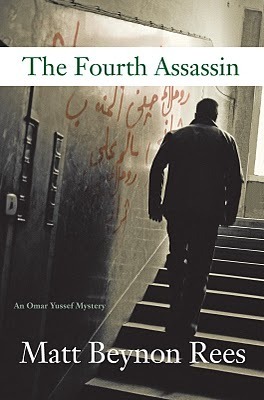
Publishers Weekly, the pre-publication review, stars my new Palestinian crime novel THE FOURTH ASSASSIN, which will be published Feb. 1 in the US and the UK. Here's the PW review: "The relentless cycle of violence and retribution follows Palestinian detective Omar Yussef to New York City, where he must deliver a speech at the U.N. on schooling in the Palestinian refugee camps, in Rees's excellent fourth mystery (after 2009's "The Samaritan's Secret"). When Yussef's son, Ala, is arrested after a decapitated body is found in Ala's Brooklyn apartment, Yussef's search for the real killer leads him from Atlantic Avenue to Coney Island and back to the U.N. Secretariat. In the process, he discovers that he's not quite the cosmopolitan man he thought himself to be, a realization shared by many Arab immigrants in the story. In truth, the residents of Little Palestine are caught between its subterranean mosques and the lure of Manhattan, where forbidden pleasures are ready for the plucking. Yussef remains reliably human and compassionate toward human fallibility, while raging openly at the corruption of his own leaders."
My Manchurian Candidate
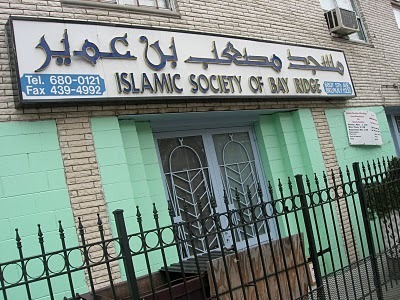
One of my biggest boosters has been Bill Ott, reviewer for the pre-publication review Booklist. Here's his review of my forthcoming THE FOURTH ASSASSIN, which is out in the US and the UK on Feb. 1:
"Road-trips in crime series have the built-in problem of removing their heroes from the landscapes that define them. Rees’ Bethlehem history teacher and occasional sleuth Omar Yussef is a strong enough character to survive a temporary transplant to New York, but that’s not to say we don’t miss the vividly evoked Palestine setting. Yussef has agreed to attend a UN conference in Manhattan because it will give him a chance to see his son Ala who is living in Brooklyn’s Little Palestine neighborhood. The reunion is spoiled, however, when Yussef finds one of Ala’s roommates dead, the victim of what appears to be a ritual killing. With Ala a suspect, Yussef attempts to find the killer. Could the history lessons that Yussef once taught Ala and his friends have been corrupted into a contemporary suicide-assassination plot? Although the setting and the high-concept thriller plot—the finale evokes The Manchurian Candidate—take us too far away from the small human dramas that usually drive this series, Yussef himself never loses sight of what he calls the life that remains when politics is sluiced away like the filth a stray dog leaves in the street."
I like what Bill sees in the novel--and its predecessors--because I've tried to make Omar Yussef a detective who confronts small aspects of the violence around him, rather than writing the kind of thriller where one guy saves the world. That wouldn't reflect the Palestinian reality.
I moved a little further from that smallness of conflict and locality with this new book. Here's why: while a "road trip" can detract from some detectives, it's in the nature of the Palestinian reality to be taken far from home. Most Palestinians, after all, live outside "Palestine." Omar Yussef is lonely and alien in New York, outside his usual milieu. Encapsulating that diaspora is one of the things about which I'm most pleased when it comes to THE FOURTH ASSASSIN.
New year, new blog
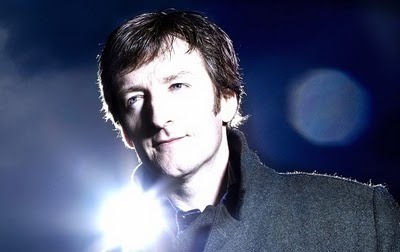
One of my favorite Italian writers, Giuseppe di Lampedusa, wrote: "If we want things to stay as they are, things will have to change." So I'm inaugurating my new blog today, to see in the New Year, with the same insightful content, of course, but a good-looking, up-to-date platform with many new features. I call the new blog The Man of Twists and Turns--check it out and you'll see the Homeric reference behind the new title. I won't be posting to my old Blogger site any more; if you've been following me on Blogger, I hope you'll come to the new blog and subscribe. You can also track my posts on Facebook and on Twitter.
The Decade that Dare not Speak its Name
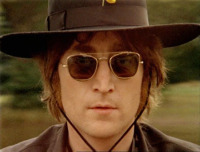 In the documentary “Imagine,” John Lennon comments that his song “Starting Over” was a message to fans his own age in which he aimed to ask them: “Hey, how’re you? Weren’t the Seventies a drag? Let’s hope the Eighties will be better.”
In the documentary “Imagine,” John Lennon comments that his song “Starting Over” was a message to fans his own age in which he aimed to ask them: “Hey, how’re you? Weren’t the Seventies a drag? Let’s hope the Eighties will be better.”If John had lived on through the Eighties to experience the decade just gone, I’m sure he’d have used a stronger word than “drag” to describe it, and it would’ve been an adjective that came easily to his lips. The noun, however, would’ve been harder to place in that sentence.
What to call the first decade of this century has been the subject of numerous articles, all of which seem to me to reflect a desire ultimately not to name the decade at all. To forget it. To put behind us its litany of disasters (Asian tsunami, Hurricane Katrina), terrorism (9/11, Madrid, London, Bombay, every third city block in Pakistan), war (Iraq, Afghanistan, the intifada) and assorted horrors (Depression, Darfur, Dick Cheney).
Op-eds opine about whether to call these 10 years the “Aughts” (an American-English misapplication of the word “nought”) or the “Naughties” or the “Zeroes” or the “Ohs.” But no one seems able to name the decade authoritatively.
That desire to forget suggests to me that the secrets of this last decade – the nastiness lurking beneath its ugly surface, the things we’d like to escape simply by refusing to name even the time in which they took place – will be perfect material for fictionalized history in years to come.
I’m thinking in particular of the kind of books James Ellroy has written about the Sixties and Seventies or David Peace about Britain in the Seventies. In “American Tabloid,” “The Cold Six Thousand” and “Blood’s a Rover,” Ellroy mined the suspicions we all had that Kennedy was really a poonhound murdered by the mob with the FBI’s connivance, that Martin Luther King went pretty much the same way, and that a group of drug-taking, pinko-fearing psychos were the engine of history, rather than people like John Lennon.
The first decade of this century seems to me prime Ellroy territory. Halliburton, Blackwater, rendition, the Patriot Act, the Department of Homeland Security all seem geared toward the secret, second history that makes Ellroy’s novels so fascinating. And the characters? Wouldn’t you like to know what really drove the recovering addict who stole the world, and what he heard from the tight lips of Uncle Dick?
In the case of Ellroy’s style, which involves using real public figures, writers have to wait for them to die, so that they can’t sue. That could hold things up. My money is on W living to be a hundred and being laid to rest in a casket made out of one of the last trees, while bloggers tweet their tributes directly into our “iFrontalcortexes.” (If I’ve violated an Apple trademark here, I apologize. Sorry, iApologize.)
So I’ve tried to get rolling on the job of fictionalizing this decade early – to show, through the prism of fiction, what really happened, and what the newspapers missed.
My series of Palestinian crime novels is intended to show the reality of life in the West Bank and Gaza during the intifada. To unveil the tribal conflicts and the battles over corrupt cash that truly dictated the course of the “uprising.” To contrast with coverage by news journalists who only got at the tip of the real meaning when they portrayed it as a struggle over a “peace process.”
I used real characters – their names changed either to protect them from attack, or to protect me and my sources from reprisals and law suits – to show the very things that journalists, who use “real” named figures in their work, failed to demonstrate.
Next month, the fourth book in the series will be out. THE FOURTH ASSASSIN takes my Palestinian sleuth Omar Yussef abroad for the first time — to New York. My aim is to examine the way the West looks at Muslims and how Muslims become marginalized or turn to extremism. To confront what we all know to be the most important issue of the decade that dare not speak its name.
You won’t find Dick Cheney in the book. But his fingerprints are all over it.



